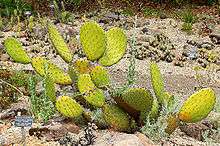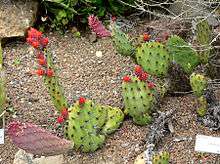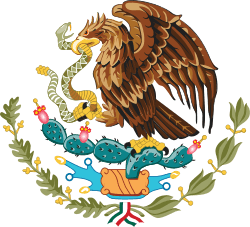Opuntia
Opuntia, commonly called prickly pear, is a genus in the cactus family, Cactaceae.[1] Prickly pears are also known as tuna (fruit), sabra, nopal (paddle, plural nopales) from the Nahuatl word nōpalli for the pads, or nostle, from the Nahuatl word nōchtli for the fruit; or paddle cactus. The genus is named for the Ancient Greek city of Opus, where, according to Theophrastus, an edible plant grew and could be propagated by rooting its leaves.[2] The most common culinary species is the Indian fig opuntia (O. ficus-indica).
| Opuntia | |
|---|---|
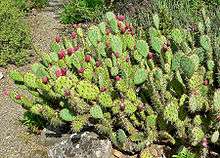 | |
| Opuntia littoralis var. vaseyi | |
| Scientific classification | |
| Kingdom: | Plantae |
| Clade: | Tracheophytes |
| Clade: | Angiosperms |
| Clade: | Eudicots |
| Order: | Caryophyllales |
| Family: | Cactaceae |
| Subfamily: | Opuntioideae |
| Tribe: | Opuntieae |
| Genus: | Opuntia Mill. |
| Species | |
|
Many, see text. | |
| Synonyms | |
and see text | |
Description
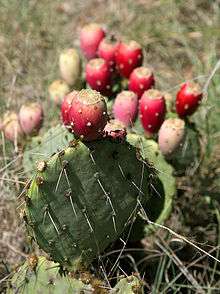
O. ficus-indica is a large, trunk-forming, segmented cactus that may grow to 5–7 m (16–23 ft) with a crown of possibly 3 m (10 ft) in diameter and a trunk diameter of 1 m (3 ft 3 in).[1] Cladodes (large pads) are green to blue-green, bearing few spines up to 2.5 cm (1 in) or may be spineless.[1] Prickly pears typically grow with flat, rounded cladodes (also called platyclades) containing large, smooth, fixed spines and small, hairlike prickles called glochids that readily adhere to skin or hair, then detach from the plant. The flowers are typically large, axillary, solitary, bisexual, and epiperigynous, with a perianth consisting of distinct, spirally arranged tepals and a hypanthium. The stamens are numerous and in spiral or whorled clusters, and the gynoecium has numerous inferior ovaries per carpel. Placentation is parietal, and the fruit is a berry with arillate seeds. Prickly pear species can vary greatly in habit; most are shrubs, but some, such as Opuntia echios of the Galápagos, are trees.
Ecology
O. ficus-indica thrives in regions with mild winters having a prolonged dry spell followed by hot summers with occasional rain and relatively low humidity.[1] A mean annual rainfall of 350–500 mm (14–19 1⁄2 in) provides good growth rates.[1] O. ficus-indica proliferates in various soils ranging from subacid to subalkaline, with clay content not exceeding 15–20% and the soil well-drained.[1] The shallow root system enables the plant to grow in shallow, loose soils, such as on mountain slopes.[1] Opuntia spreads into large clonal colonies, which contribute to its being considered a noxious weed in some places.[1][3]
Animals that eat Opuntia include the prickly pear island snail and Cyclura rock iguanas. The fruit are relished by many arid-land animals, chiefly birds, which thus help distribute the seeds. Opuntia pathogens include the sac fungus Colletotrichum coccodes and Sammons' Opuntia virus. The ant Crematogaster opuntiae and the spider Theridion opuntia are named because of their association with prickly pear cactus.
Taxonomy
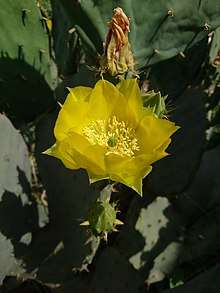
_-_Buds.jpg)
When Carl Linnaeus published Species Plantarum in 1753 – the starting point for modern botanical nomenclature – he placed all the species of cactus known to him in one genus, Cactus. In 1754, the Scottish botanist Philip Miller divided them into several genera, including Opuntia. He distinguished the genus largely on the form of its flowers and fruits.[4]
Considerable variation of taxonomy occurs within Opuntia species, resulting in names being created for variants or subtypes within a species, and use of DNA sequencing to define and isolate various species.[1]
Selected species
Opuntia hybridizes readily between species.[3] This can make classification difficult, yielding a reticulate phylogeny where different species come together in hybridization.[5] Also, not all species listed here may actually belong in this genus, meaning that Opuntia is not a monophyletic group.
Opuntia also has a tendency for polyploidy. The ancestral diploid state was 2n=22, but many species are hexaploid (6n = 66) or octaploid (8n = 88).[5]
- Opuntia abjecta
- Opuntia aciculata – Chenille prickly pear, old man's whiskers, cowboy's red whiskers
- Opuntia alta
- Opuntia ammophila
- Opuntia anacantha
- Opuntia anahuacensis
- Opuntia arenaria – dune prickly pear; diploid (2n=22)
- Opuntia articulata
- Opuntia atrispina
- Opuntia auberi
- Opuntia aurantiaca
- Opuntia aurea hexaploid (2n=66)
- Opuntia aureispina
- Opuntia azurea
- Opuntia basilaris – beavertail cactus; diploid (2n=22)
- Opuntia bentonii
- Opuntia blakeana
- Opuntia boldinghii
- Opuntia cacanapa - including Opuntia ellisiana (Ellisiana)
- Opuntia camanchica - plains prickly pear
- Opuntia canada
- Opuntia cespitosa
- Opuntia charlestonensis
- Opuntia chaffeyi
- Opuntia chlorotica – pancake prickly pear; native to southwest USA and the Sonoran and Mojave deserts; diploid (2n=22)
- Opuntia chisosensis
- Opuntia clavata
- Opuntia cochenillifera
- Opuntia comonduensis
- Opuntia columbiana
- Opuntia confusa
- Opuntia covillei
- Opuntia curassavica Curacao prickly pear
- Opuntia curvospina tetraploid (2n=44)
- Opuntia cyclodes
- Opuntia cymochila – grassland prickly pear; One of the most common species found on the Great Plains of the United States
- Opuntia debreczyi
- Opuntia decumana
- Opuntia decumbens – nopal de culebra
- Opuntia dejecta
- Opuntia dillenii
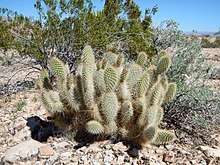
- Opuntia diploursina – found around Grand Canyon and Lake Mead National Recreation Area; diploid (2n=22); resembles O. trichophora
- Opuntia discata
- Opuntia dulcis - syn. O. phaeacantha major
- Opuntia echinocarpa - see Cylindropuntia echinocarpa
- Opuntia echios
- Opuntia echios var. gigantea – Galápagos prickly pear, Galápagos Islands
- Opuntia elata
- Opuntia elatior Mill. – syn. O. bergeriana
- Opuntia engelmannii – Engelmann's prickly pear, cow's-tongue prickly pear, desert prickly pear, discus prickly pear, Texas prickly pear, calico cactus; hexaploid (2n=66)
- Opuntia erinacea tetraploid (2n=44)
- Opuntia exaltata
- Opuntia excelsa
- Opuntia ficus-barbarica
- Opuntia ficus-indica – Indian fig opuntia
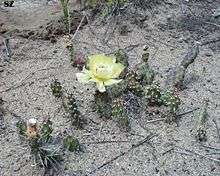
- Opuntia fragilis – little prickly pear, brittle cactus, found in the Great Plains and as far west as British Columbia]
- Opuntia galapageia
- Opuntia gosseliniana – violet prickly pear
- Opuntia gosseliniana var. santa-rita – Santa Rita prickly pear
- Opuntia chlorotica var. gosseliniana
- Opuntia helleri
- Opuntia hickenii
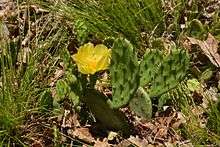
- Opuntia humifusa – eastern prickly pear (sometimes included in O. compressa);tetraploid (2n=44)
- Opuntia hyptiacantha
- Opuntia inamoema K. Schum. – quipá
- Opuntia insularis
- Opuntia invicta syn. Corynopuntia invicta, Grusonia invicta
- Opuntia jamaicensis
- Opuntia laevis
- Opuntia lasiacantha
- Opuntia leucotricha – arborescent prickly pear, Aaron's beard cactus, semaphore cactus, Duraznillo blanco, nopal blanco
- Opuntia lindheimeri – cowtongue prickly pear
- Opuntia littoralis – coastal prickly pear, sprawling prickly pear
- Opuntia longispina
- Opuntia macrocentra – black-spined prickly pear, purple prickly pear, found in southwest USA and northern Mexico
- Opuntia macrorhiza – Plains prickly pear, found throughout the Great Plains except for the northernmost areas (not found in North Dakota), and extending sporadically eastward as far as Kentucky, syn. O. leptocarpa MacKensen, O. tenuispina Engelm., O. tortispina Engelm. & Bigelow; tetraploid (2n=44)
- Opuntia matudae – xoconostle (syn. Opuntia joconostle)
- Opuntia maldonandensis
- Opuntia maxima
- Opuntia megacantha
- Opuntia megarrhiza
- Opuntia megasperma
- Opuntia microdasys – bunny ears cactus, polka-dot cactus
- Opuntia monacantha – common prickly pear
- Opuntia nemoralis
- Opuntia nichollii - Distributed throughout much of the Colorado Plateau, from Grand Canyon north to Price, Utah and east to the Colorado border; hexaploid (2n=66)
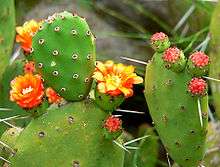
- Opuntia ovata
- Opuntia pachyrrhiza
- Opuntia pailana
- Opuntia paraguayensis
- Opuntia phaeacantha – tulip prickly pear, includes plateau prickly pear, brown-spined prickly pear, Mojave prickly pear, Kingman prickly pear; hexaploid (2n=66)
- Opuntia picardoi
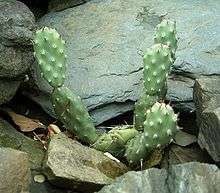
- Opuntia pinkavae – Pinkava's prickly pear; octoploid (2n=88)
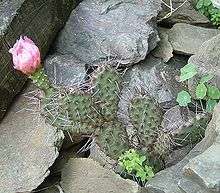
- Opuntia polyacantha – Panhandle prickly pear, found in the Great Plains, Great Basin, Mojave Desert, Colorado Plateau, and the Rocky Mountains, syn. O. rhodantha K.Schum.; tetraploid (2n=44)
- Opuntia polyacantha var. arenaria (syn. O. erinacea)
- Opuntia pubescens (syn. O. pascoensis Britton & Rose)
- Opuntia pusilla – creeping cactus, syn. O. drummondii Graham
- Opuntia quitensis – Red Buttons opuntia (syn. O. macbridei, O. johnsonii, Platyopuntia quitensis)
- Opuntia rastrera
- Opuntia repens
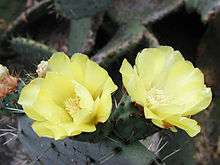
- Opuntia robusta
- Opuntia rufida (sometimes included in O. microdasys)
- Opuntia saxicola
- Opuntia schumannii
- Opuntia soehrensii
- Opuntia stenopetala (syn. O. riviereana Backeb.)
- Opuntia streptacantha
- Opuntia stricta – erect prickly pear, spineless prickly pear
- Opuntia sulphurea
- Opuntia taylori
- Opuntia tehuantepecana – nopal de caballo
- Opuntia tomentosa – woollyjoint prickly pear
- Opuntia triacantha
- Opuntia trichophora diploid (2n=22)
- Opuntia tuna
- Opuntia velutina
- Opuntia violacea
Formerly in Opuntia
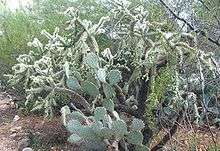
- Austrocylindropuntia
- Brasiliopuntia
- Corynopuntia
- Cylindropuntia
- Disocactus phyllanthoides (as Opuntia speciosa)
- Micropuntia
- Miqueliopuntia
Chollas
Chollas, now recognized to belong to the distinct genus Cylindropuntia, are distinguished by having cylindrical, rather than flattened, stem segments with large barbed spines. The stem joints of several species, notably the jumping cholla (Cylindropuntia fulgida), are very brittle on young stems, readily breaking off when the barbed spines stick to clothing or animal fur as a method of vegetative reproduction. The barbed spines can remain embedded in the skin, causing discomfort and sometimes injury.
Distribution
Like most true cactus species, prickly pears are native only to the Americas. Through human actions, they have since been introduced to many other areas of the world.[1][5] Prickly pear species are found in abundance in Mexico, especially in the central and western regions, and in the Caribbean islands (West Indies). In the United States, prickly pears are native to many areas of the arid, semiarid, and drought-prone Western and South Central United States, including the lower elevations of the Rocky Mountains and southern Great Plains, where species such as Opuntia phaeacantha and Opuntia polyacantha become dominant, and to the desert Southwest, where several types are endemic. Prickly pear cactus is also native to sandy coastal beach scrub environments of the East Coast from Florida to southern Connecticut, where Opuntia humifusa, Opuntia stricta, and Opuntia pusilla, are found from the East Coast south into the Caribbean and the Bahamas. Additionally, the eastern prickly pear is native to the midwestern "sand prairies" nearby major river systems, such as the Mississippi, Illinois, and Ohio rivers.[6] The plant also occurs naturally in hilly areas of southern Illinois, and sandy or rocky areas of northern Illinois.[7]
Opuntia species are the most cold-tolerant of the lowland cacti, extending into western and southern Canada; one subspecies, O. fragilis var. fragilis, has been found growing along the Beatton River in central British Columbia, southwest of Cecil Lake at 56° 17’ N latitude and 120° 39’ W longitude.[8]
Prickly pears also produce a fruit, commonly eaten in Mexico and in the Mediterranean region, known as tuna; it also is used to make aguas frescas.[1] The fruit can be red, wine-red, green, or yellow-orange. In the Galápagos Islands, six different species are found: O. echios, O. galapageia, O. helleri, O. insularis, O. saxicola, and O. megasperma. These species are divided into 14 different varieties; most of these are confined to one or a few islands, so they have been described as "an excellent example of adaptive radiation".[9] On the whole, islands with tall, trunked varieties have giant tortoises, and islands lacking tortoises have low or prostrate forms of Opuntia. Prickly pears are a prime source of food for the common giant tortoises in the Galápagos Islands, so they are important in the food web.
Charles Darwin was the first to note that these cacti have thigmotactic anthers; when the anthers are touched, they curl over, depositing their pollen. This movement can be seen by gently poking the anthers of an open Opuntia flower. The same trait has evolved convergently in other species (e.g. Lophophora).
The first introduction of prickly pears into Australia is ascribed to Governor Phillip and the earliest colonists in 1788. Brought from Brazil to Sydney, prickly pear grew in Sydney, New South Wales, where they were rediscovered in a farmer's garden in 1839. They appear to have spread from New South Wales and caused great ecological damage in the eastern states. They are also found in the Mediterranean region of Northern Africa, especially in Morocco and Tunisia, where they grow all over the countryside, and in parts of Southern Europe, especially Spain, where they grow in the east, south-east, and south of the country, and also in Malta, where they grow all over the islands. They can be found in enormous numbers in parts of South Africa, where they were introduced from South America. Prickly pears are considered an invasive species in Australia, Ethiopia, South Africa, and Hawaii, among other locations.[1]
Prickly pears (mostly Opuntia stricta) were originally imported into Europe during the 1500s[1] and Australia in the 18th century for gardens, and were later used as a natural agricultural fencing[10] and in an attempt to establish a cochineal dye industry. In Australia, they quickly became a widespread invasive weed, eventually converting 260,000 km2 (101,000 sq mi) of farming land into an impenetrable green jungle of prickly pear, in places 6 m (20 ft) high. Scores of farmers were driven off their land by what they called the "green hell"; their abandoned homes were crushed under the cactus growth, which advanced at a rate of 4,000 km2 (1,000,000 acres) per year.[10] In 1919, the Australian federal government established the Commonwealth Prickly Pear Board to coordinate efforts with state governments to eradicate the weed. Early attempts at mechanical removal and poisonous chemicals failed, so in a last resort, biological control was attempted.[10] The moth Cactoblastis cactorum, from South America, whose larvae eat prickly pear, was introduced in 1925 and rapidly reduced the cactus population. The son of the noted entomologist Frederick Parkhurst Dodd, Alan Dodd, was a leading official in combating the prickly pear menace. A memorial hall in Chinchilla, Queensland, commemorates the moth.[10]
Natural distribution occurs via consumption and seed dispersal by many animals, including antelopes, nonhuman primates, elephants, birds, and humans.[1]
Growth
- Bud appears ►
- Bud grows ►
- Bud begins pad transformation ►
- Bud completes pad transformation ►
- Pad continues growth ►
- Edible pad (tender) ►
- Mature pad
As food
| Nutritional value per 100 g (3.5 oz) | |
|---|---|
| Energy | 172 kJ (41 kcal) |
9.6 g | |
| Dietary fiber | 3.6 g |
0.5 g | |
0.7 g | |
| Vitamins | Quantity %DV† |
| Vitamin A equiv. | 3% 25 μg |
| Riboflavin (B2) | 8% 0.1 mg |
| Niacin (B3) | 3% 0.5 mg |
| Vitamin B6 | 8% 0.1 mg |
| Folate (B9) | 2% 6 μg |
| Vitamin C | 17% 14.0 mg |
| Vitamin E | 0% 0 mg |
| Minerals | Quantity %DV† |
| Calcium | 6% 56 mg |
| Iron | 2% 0.3 mg |
| Magnesium | 24% 85 mg |
| Phosphorus | 3% 24 mg |
| Potassium | 5% 220 mg |
| Zinc | 1% 0.1 mg |
| Other constituents | Quantity |
| Water | 88 g |
| |
| †Percentages are roughly approximated using US recommendations for adults. Source: USDA Nutrient Database | |
Nutrition
Raw opuntia leaves are 88% water, 10% carbohydrates, and less than 1% both of protein and fat (table). In a 100-g reference amount, raw leaves provide 41 calories, 17% of the Daily Value (DV) for vitamin C, and 24% DV for magnesium, with no other micronutrients in significant content (table).
Regional food uses
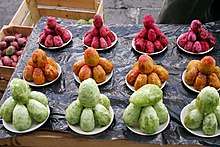
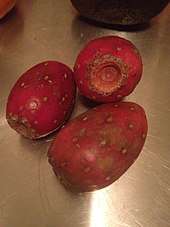
The fruit of prickly pears, commonly called cactus fruit, cactus fig, Indian[11] fig, nopales[12] or tuna in Spanish,[13] is edible, although it must be peeled carefully to remove the small spines on the outer skin before consumption. If the outer layer is not properly removed, glochids can be ingested, causing discomfort of the throat, lips, and tongue, as the small spines are easily lodged in the skin. Native Americans like the Tequesta would roll the fruit around in a suitable medium (e.g. grit) to "sand" off the glochids. Alternatively, rotating the fruit in the flame of a campfire or torch has been used to remove the glochids. Today, parthenocarpic (seedless) cultivars are also available.
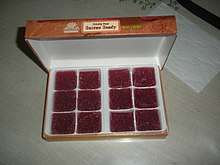
In Mexico, prickly pears are often used to make appetizers, soups, salads, entrees, vegetable dishes, breads, desserts, beverages, candy, jelly, and drinks.[12][14][15] The young stem segments, usually called nopales, are also edible in most species of Opuntia.[12] They are commonly used in Mexican cuisine in dishes such as huevos con nopales (eggs with nopal), or tacos de nopales. Nopales are also an important ingredient in New Mexican cuisine.[12] In 2009 it was introduced as a cheaper alternative to corn for the production of tortillas and other corn products.[16]
Opuntia ficus-indica has been introduced to Europe, and flourishes in areas with a suitable climate, such as the south of France and southern Italy: In Sicily, they are referred to as fichi d'India (Italian literal translation of Indian fig) or ficurinia (Sicilian dialect literal translation of Indian fig). In Sardinia, they are called figumorisca - Moorish figs). They can be found also in the Struma River in Bulgaria, in southern Portugal and Madeira (where they are called tabaibo, figo tuno, or "Indian figs"), in Andalusia, Spain (where they are known as higos chumbos). In Greece, it grows in such places as the Peloponnese region, Ionian Islands, or Crete, and its figs are known as frangosyka (Frankish, i.e. Western European, figs) or pavlosyka (Paul's figs), depending on the region. In Albania, they are called fiq deti translated as 'sea figs', and are present in the south-west shore. The figs are also grown in Cyprus, where they are known as papoutsósyka or babutsa (cactus figs).
The prickly pear also grows widely on the islands of Malta, where it is enjoyed by the Maltese as a typical summer fruit (known as bajtar tax-xewk, literally 'spiny figs'), as well as being used to make the popular liqueur known as bajtra.[17] The prickly pear is so commonly found in the Maltese islands, it is often used as a dividing wall between many of Malta's characteristic terraced fields in place of the usual rubble walls.
The prickly pear was introduced to Eritrea during the period of Italian colonisation between 1890 and 1940. It is locally known there as beles and is abundant during the late summer and early autumn (late July through September). The beles from the holy monastery of Debre Bizen is said to be particularly sweet and juicy. In Libya, it is a popular summer fruit and called by the locals Hindi, which literally means Indian.
In Morocco, Tunisia, Libya, Saudi Arabia, Jordan, and other parts of the Middle East, prickly pears of the yellow and orange varieties are grown by the side of farms, beside railway tracks and other otherwise noncultivable land. It is sold in summer by street vendors, and is considered a refreshing fruit for that season.
Tungi is the local St. Helenian name for cactus pears. The plants (Indian fig opuntia) were originally brought to the island by the colonial ivory traders from East Africa in the 1850s. Tungi cactus now grows wild in the dry coastal regions of the island. Three principal cultivars of tungi grow on the island: the 'English' with yellow fruit; the 'Madeira' with large red fruit; and the small, firm 'spiny red'.Tungi also gives its name to a local Spirit distilled at The St Helena distillery at Alarm Forest, the most remote distillery in the world, made entirely from the opuntia cactus.
Phytochemicals and folk medicine
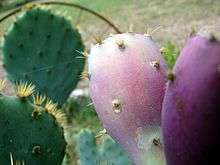
Opuntia contains a range of phytochemicals in variable quantities, such as polyphenols, dietary minerals and betalains.[18][19] Identified compounds under basic research include gallic acid, vanillic acid and catechins, as examples.[18] The Sicilian prickly pear contains betalain, betanin, and indicaxanthin, with highest levels in their fruits.[19]
In Mexican folk medicine, its pulp and juice are considered treatments for wounds and inflammation of the digestive and urinary tracts,[20] although there is no high-quality evidence for any clinical benefit of using opuntia for these purposes.
Years before modern Western medicine, Native Americans and Mexicans primarily used Opuntia as a coagulant for open wounds, using the pulp of the stem either by splitting the stem or scraping out the pulp. [21]
In one recent study, it was found that Opuntia aided in the prevention or slow down of diabetes, obesity, metabolic syndrome, cardiovascular disease, and some cancers. The results of the group that was taking Opuntia showed a reduction in BMI, body composition, and waist circumference when compared to the placebo group.[22]
Other uses
In dye production
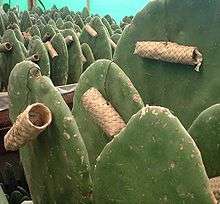
Dactylopius coccus is a scale insect from which cochineal dye is derived. D. coccus itself is native to tropical and subtropical South America and Mexico. This insect, a primarily sessile parasite, lives on cacti from the genus Opuntia, feeding on moisture and nutrients in the cactus sap. The insect produces carminic acid, which deters predation by other insects. The carminic acid can be extracted from the insect's body and eggs to make the red dye.
Cochineal is used primarily as a red food colouring and for cosmetics.[12] The cochineal dye was used by the Aztec and Maya peoples of Central and North America, and by the Inca in South America. Produced almost exclusively in Oaxaca, Mexico, by indigenous producers, cochineal became Mexico's second-most valued export after silver.[23] The dyestuff was consumed throughout Europe, and was so highly valued, its price was regularly quoted on the London and Amsterdam Commodity Exchanges.
The biggest producers of cochineal are Peru, the Canary Islands, and Chile. Current health concerns over artificial food additives have renewed the popularity of cochineal dyes, and the increased demand is making cultivation for insect farming an attractive opportunity in other regions, such as in Mexico, where cochineal production had declined again owing to the numerous natural enemies of the scale insect.[24]
Apart from cochineal, the red dye betanin can be extracted from some Opuntia plants themselves.[12]
For animal fodder
Cactus is used as a fodder crop for animals in arid and dryland regions.[25]
As a source of "vegan leather"
The thick skin of nopal cactus can be harvested as an environmentally-friendly leather replacement superior to real leather. [26]
For fuel
Bioethanol can be produced from some Opuntia species.[27]
For bioplastic
Nopal juice can be used to produce bioplastic.[28]
In culture
The coat of arms of Mexico depicts a Mexican golden eagle, perched upon an Opuntia cactus, holding a rattlesnake. According to the official history of Mexico, the coat of arms is inspired by an Aztec legend regarding the founding of Tenochtitlan. The Aztecs, then a nomadic tribe, were wandering throughout Mexico in search of a divine sign to indicate the precise spot upon which they were to build their capital. Their god Huitzilopochtli had commanded them to find an eagle devouring a snake, perched atop a cactus that grew on a rock submerged in a lake. After 200 years of wandering, they found the promised sign on a small island in the swampy Lake Texcoco. There they founded their new capital, Tenochtitlan. The cactus (O. ficus-indica; Nahuatl: tenochtli), full of fruits, is the symbol for the island of Tenochtitlan.
.svg.png)
The 1975–1988 version of the emblem of Malta also featured a prickly pear, along with a traditional dgħajsa, a shovel and pitchfork, and the rising sun.[29]
In Arabic, the cactus is called صبار ṣubbār; the related term sabr also translates to "patience" or "tenacity".[30] The cactus fig is called tsabar (Hebrew: צבר) in Hebrew. This cactus is also the origin of the term sabra used to describe a Jew born in Israel. The allusion is to a thorny, spiky skin on the outside, but a soft, sweet interior, suggesting, though the Israeli sabras are rough on the outside, they are sweet and sensitive once one gets to know them.[31][32]
The prickly pear cactus has been used for centuries both as a food source and a natural fence that keeps in livestock and marks the boundaries of family lands.[12] They are resilient and often grow back following removal.[12]
The cactus lends its name to a song by British jazz/classical group Portico Quartet. The song "My Rival", on the album Gaucho by the American jazz-pop group Steely Dan begins with the words, "The wind was driving in my face/The smell of prickly pear."[33]
In the fall of 1961, Cuba had its troops plant an 13-kilometre (8 mi) barrier of Opuntia cactus along the northeastern section of the 28-kilometre (17 mi) fence surrounding the Guantanamo Bay Naval Base to stop Cubans from escaping Cuba to take refuge in the United States.[34] This was dubbed the "Cactus Curtain", an allusion to Europe's Iron Curtain[35] and the Bamboo Curtain in East Asia.
Uruguayan-born footballer Bruno Fornaroli is nicknamed prickly pear due to his sometimes spiky hairstyles.[36]
See also
- Cactus fries – a deep-fried food prepared from Opuntia pads
- Prickly pears in Australia
- Prickly pears in South Africa
References
- "Opuntia ficus-indica (prickly pear)". CABI. 3 January 2018. Retrieved 23 May 2018.
- Quattrocchi, Umberto (2000). CRC World Dictionary of Plant Names. III M-Q. CRC Press. p. 1885. ISBN 978-0-8493-2677-6.
- Griffith, M. P. (2004). "The origins of an important cactus crop, Opuntia ficus-indica (Cactaceae): New molecular evidence". American Journal of Botany. 91 (11): 1915–1921. doi:10.3732/ajb.91.11.1915. PMID 21652337.
- Miller, Philip (1754). "Opuntia". The Gardener's Dictionary. v.2 (4th ed.). London: John & James Rivington. Retrieved 2014-06-13.
- Majure, Lucas C.; Puente, Raul; Griffith, M. Patrick; Judd, Walter S.; Soltis, Pamela S.; Soltis, Douglas E. (2012-05-01). "Phylogeny of Opuntia s.s. (Cactaceae): Clade delineation, geographic origins, and reticulate evolution". American Journal of Botany. 99 (5): 847–864. doi:10.3732/ajb.1100375. ISSN 0002-9122. PMID 22539520.
- "Sand prairie". Illinois Department of Natural Resources. 2020. Retrieved 23 January 2020.
- "Eastern prickly pear, Opuntia humifusa, Cactus family (Cactaceae)". Illinois Wildflowers. Retrieved 23 January 2020.
- Cota-Sánchez (2002).
- Fitter, Fitter, and Hosking, Wildlife of the Galapagos (2000)
- Patterson, Ewen K. 1936. The World's First Insect Memorial. "The Review of the River Plate", December pp. 16–17
- Originally meaning "Native American", though the specific epithet, "ficus-indica", means "fig from India". Note also Ficus benghalensis, which is both a true fig tree and from South Asia.
- Yvonne Savio (1989). "Prickly pear cactus production". Small Farm Center. University of California – Davis. Retrieved 23 December 2015.
- Grigson, Jane (2007). Jane Grigson's Fruit Book. U of Nebraska Press. p. 380. ISBN 978-0-8032-5993-5.
- Midey, Connie (May 31, 2005). "A magical plant". The Arizona Republic. Retrieved May 22, 2010.
- Jarman, Max (October 11, 2005). "Hand crafted hooch: Prickly pear vodka from Flagstaff". The Arizona Republic. Retrieved May 22, 2010.
- Trevino, Miguel Trancozo. "The remarkable power of the prickly pear". www.bbc.com. Retrieved 2020-06-01.
- George Cini (March 20, 2003). "Zeppi's Bajtra, the liqueur from the prickly pear fruit". Times of Malta.
- Guzmán-Maldonado, S. H.; et al. (2010). "Physicochemical, Nutritional, and Functional Characterization of Fruits Xoconostle (Opuntia matudae) Pears from Central-México Region". Journal of Food Science. 75 (6): C485–92. doi:10.1111/j.1750-3841.2010.01679.x. PMID 20722901.
- Butera, Daniela; et al. (2002). "Antioxidant activities of sicilian prickly pear (Opuntia ficus indica) fruit extracts and reducing properties of its betalains: betanin and indicaxanthin". Journal of Agricultural and Food Chemistry. 50 (23): 6895–6901. doi:10.1021/jf025696p. hdl:10447/107910. PMID 12405794.
- Frati AC, Xilotl Díaz N, Altamirano P, Ariza R, López-Ledesma R (1991). "The effect of two sequential doses of Opuntia streptacantha upon glycemia". Archivos de Investigación Médica. 22 (3–4): 333–6. PMID 1844121.
- del Socorro Santos Díaz, María; Barba de la Rosa, Ana-Paulina; Héliès-Toussaint, Cécile; Guéraud, Françoise; Nègre-Salvayre, Anne (2017). "Opuntia spp.: Characterization and Benefits in Chronic Diseases". Oxidative Medicine and Cellular Longevity. 2017: 8634249. doi:10.1155/2017/8634249. PMC 5401751. PMID 28491239.
- Mayes, V., Lacy, B. B., Ahasteen, J., & Chee, J. (2012). Nanise’: A Navajo herbal: One Hundred Plants from the Navajo Reservation. Chandler, AZ: Five Star Publications, Inc.
- Behan (1995).
- Portillo & Vigueras (1988).
- Lee Allen (January 15, 2016). "Strategic fodder – cactus to the rescue as livestock feed". FarmProgress. Retrieved 25 February 2020.
- Derya Ozdemir (June 23, 2020). "Creating Leather From Cactus to Save Animals and the Environment". Interesting Engineering. Retrieved 23 June 2020.
- Ciriminna, Rosaria; Delisi, Riccardo; Albanese, Lorenzo; Meneguzzo, Francesco; Pagliaro, Mario (21 February 2017). "Opuntia ficus-indica seed oil: Biorefinery and bioeconomy aspects". European Journal of Lipid Science and Technology. 119 (8): 1700013. doi:10.1002/ejlt.201700013. ISSN 1438-7697.
- Liz Gyekye (June 5, 2019). "BBC covers biodegradable bioplastics made from cactus juice". BioMarket Insights. Retrieved February 25, 2020.
- Bonello, Giovanni (8 May 2011). "Malta's three national emblems since independence – what's behind them?". Times of Malta. Retrieved 30 October 2014.
- Tamir, Tally (1999). "The Shadow of Foreignness: On the Paintings of Asim Abu-Shakra". Palestine-Israel Journal. 6 (1).
- Almog, Oz (2000). The Sabra: The Creation of the New Jew. Translated by Haim Watzman. University of California Press. ISBN 978-0-520-21642-6. Retrieved 2018-04-17.
- "Over here and over there". The Economist. Nov 16, 2006. Retrieved 2007-10-16.
- "Lyrics | Gaucho (1980) — My Rival". www.steelydan.com. Archived from the original on 2006-11-04. Retrieved 2010-05-08.
- "Guantanamo Bay Naval Base and Ecological Crises". Trade and Environment Database. American University. Archived from the original on 2009-03-27. Retrieved 2009-04-19.
- "Yankees Besieged". Time. March 16, 1962.
- Hill, Simon (11 December 2019). "Bruno Fornaroli proving a smart acquisition for Melbourne City". The Daily Telegraph. Sydney: News Corp. Retrieved 19 October 2019.
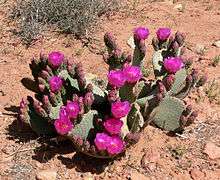
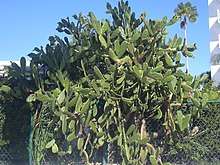
.jpg)
